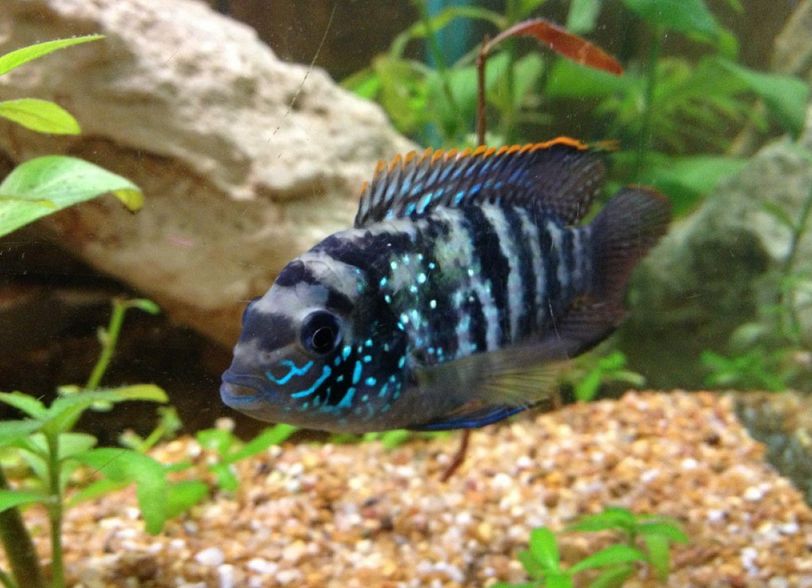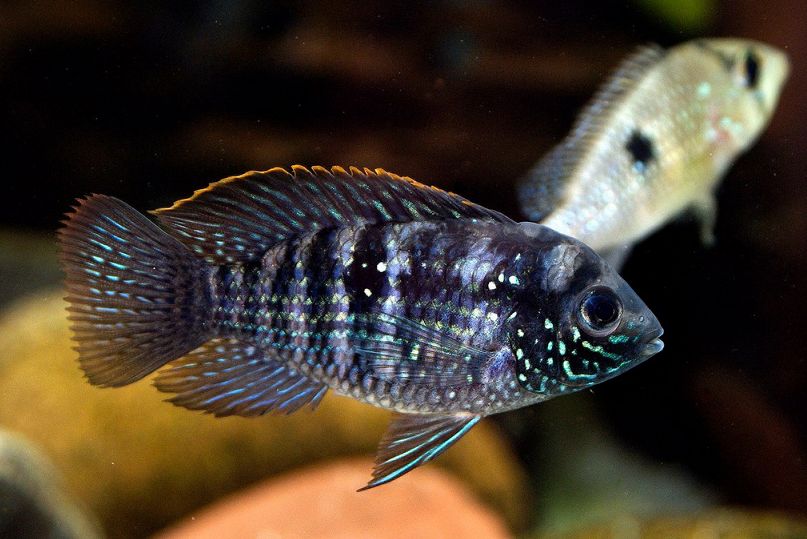How Long Before a Blue Acara Id Fully Grown
Blue acara (lat. Aequidens pulcher) for long period of time was one of the most popular South America cichlid fishes kept in a tank for many generations of aquarists. There is a good reason that its name (pulcher) from Latin – means beautiful.

Blue acara is often mistaken for another related species – Andinoacara rivulatus (Green terror cichlid). But these fishes differ sufficiently.
Green terror cichlid is larger and in the wild its max size can be 25-30 cm (10-12 in) when Aequidens pulcher is just about 20 cm (8 in) long. Green terror male when it becomes reproductive develops a pronounced hump on its head, while blue acara hump is less pronounced.
This cichlid is a great fish for the aquarists willing to have their first cichlid in a tank.
Care is rather easy – it's necessary just to control water parameters and give the fish qualitative feed. Blue acaras are good and caring parents and they spawn easy enough.
Habitat in the wild
Aequidens pulcher was first described in 1858. The fish inhabits in Central and South America: Columbia, Venezuela, Trinidad.
Fish can be seen both in flowing and impounded waters, where it feeds on insects, spineless species, different juveniles.
Description
They has an oval shaped stocky body with sharpened proctal and dorsal fins. This is a middle sized cichlid which max size in the wild is about 20 cm (8 in), but in a tank size is about 15 cm (6 in).
Lifespan can be about 7-10 years. The fish becomes reproductive when its body is about 6-6.5 cm long and breeding starts when body length is 10 cm.
The name of the fish says about its color. The body color is gray and blue with several vertical black bands and sparkles scattered over the body.
Nowadays a new color of this fish becomes more and more popular – electric blue acara cichlid (Nannacara sp. Neon blue).

The whole body of the fish is blue and it reminds the coloring of flower horn Thai silk.
Electric blue acara has just appeared on the market and it's almost unavailable for sale. It's still not clear if it's hybrid or some different kind of fish not described until now.
Difficulties in keeping
The blue acara isn't demanding therefore it's good for beginners unlike green terror. Since they doesn't grow that big as other cichlid fishes do, therefore it requires significantly smaller tanks.
The fish also isn't demanding as for the feed or breeding. The only thing to be controlled carefully is water parameters and purity.

Feeding
Blue acara are carnivorous feeders, but first of all and the fish requires feed with high protein content. In the nature feeds on worms, larvas, spineless species.
In a tank the fish eagerly feeds on blood worm, tubifex, white worms, brine shrimp. Frozen feed is also good for diet – brine shrimp, cyclops and artificial feed – tablets and flakes.
It's better to feed the fish twice a day with small portions of feed changing its types in the morning and in the evening.
I myself give some of this food to my pets and as for the rest I've heard and read lots of good reviews.
Yet, all of the food is of high quality and it is the best one for this fish kind as well as it keeps the tank water clean.
Care and keeping in a tank
| Scientific Name | Aequidens pulcher |
| Common Name | Blue acara, acara fish, blue acara cichlid, acara cichlid, |
| Tank size | 30 gallons (115L) and more |
| Temperament | Peaceful/Territorial |
| Diet | Omnivorous |
| Temperature | 22–30 °C (72–86 °F) |
| pH | 6.5-7.5 |
| Size | 20 cm (7.9 in) |
A tank of 30 gallons capacity is needed for couple. Fine river sand is better to be used as a tank bottom because cichlid fish likes digging it.
Therefore, it's better to put large plants in flowerpots in the tank. Also it's necessary to create some covers where the fish can hide when it's stressed.
Dry fallen indian almond leaves and beech can be put on the tank bottom. Besides the fact that they create water parameters close to the ones where fish lives in the wild, they are also source of feed for juveniles.
It's important to renew water and siphonate the tank bottom regularly. Apart from clean water blue acara also likes water flows and it's better to use good canister filter. The fish adapts to water parameters rather good, but the ideal water parameters for it are the following: water temperature 22-30 C, ph: 6.5-7,5 , 3 – 20 dGH.
Compatibility and tank mates
This fish is more good-tempered then other cichlids, even more then green terror cichlid.
It's middle sized and peaceful fish, so other cichlid can be tank mates as well as catfishes and fishes of the same size.
Remember, that it's still a cichlid fish and don't keep it in a tank together with small fishes (like neon tetra) and cherry shrimps. Cichlid should be kept only with the fishes of close size or larger.
Although the fish isn't aggressive, they guard their territory, especially during the spawning period. Also they like digging the tank bottom and they dig out plants.
Best tank mates are: firemouth cichlid, angelfish, convict cichlid, Jack Dempsey cichlid, jaguar cichlid and different catfishes: leopard pleco, plecostomus, bristlenose pleco.
Gender differences: male vs female
Males are more colorful and they are larger then females. Also they have elongated fins end. Both male and female dark vertical bands become even more dark when breeding and especially when caring for their juveniles.
Breeding
Blue acara cichlids live rather friendly together and they form couples. Usually they don't attack other fishes and they scare away their tank mates only if they trespass their territory or during the spawning period.
However, they can spawn each two weeks at the condition that the eggs are taken away right after spawning.
Fishes becomes reproductive at the age of 9-11 month. It can spawn in a community tank, but sure it's better to use a spawning pond for this purpose.
A tank of 100 liters capacity with good aeration will do. It should have some plants. Coarse sand should be used as a tank bottom with big flat rocks, snags on it which lately serve as a substrate for spawning.
Water parameters for breeding are: hardness 6-20°, pH 6,5-7,0, temperature 25-28 °C.
Spawning can be stimulated by frequent water renew, high aeration and water temperature increase by 2-3 °C. As it was mentioned above, big flat rocks, flowerpots, snags and pits in the sand (which the fish digs itself) can become a substrate for breeding.
During their spawning period acara becomes aggressive and they intensely guard their territory from tank mates intrusion.
Female can lay from 400 to 1000 eggs. Sometimes, the fishes eat their first breed, but later they stop doing it.
Incubation period lasts from 3 to 7 days (depending on the water temperature). After the ich fry appears its parents move it in their mouth into the pits in the sand prepared in advance.
In anoter 3-4 days the juveniles start swimming and feeding. Start feed for juveniles is: freshly hatched brine shrimp, rotifers, nematodes.
gainesbradoet1988.blogspot.com
Source: https://meethepet.com/blue-acara-aequidens-pulcher/
0 Response to "How Long Before a Blue Acara Id Fully Grown"
Post a Comment